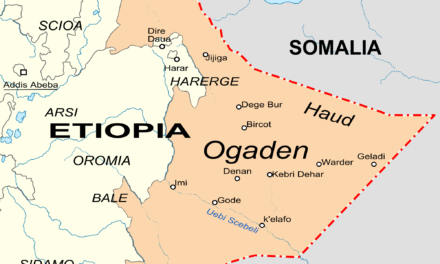Ethiopia’s latest Notification Note on COVID-19 Situational Update paints the picture of a country that is relatively in good shape and very much in control of the spread of the pandemic across the country: 123 cases and 3 deaths to date.
The report also indicates a total of 13,645 laboratory tests carried out. 957 tests were conducted during the past 24 hours, with only one new case confirmed in Jigjiga, the Capital of the Somali Regional State (SRS). These are encouraging numbers. And the temptation to congratulate the leadership of the country, in particular the Minister of Health and her team, is strong, even irresistible.
However, two key factors prompt everyone to exercise a great deal of caution. The first concerns the nature and epidemiology of COVID-19. The second relates to what we know about Ethiopian history, sociology, and governance.
What We Know about the Coronavirus
The novel coronavirus is a new virus. The first reports of its existence emerged in December last year. Scientists and experts of infectious diseases do not yet know much about it. what is known is very limited and extremely frightening. It has been given a name: severe acute respiratory syndrome coronavirus 2 (SARS-CoV-2). And the disease it causes has a name: coronavirus disease 2019 (COVID-19). Chinese and French scientists have mapped and sequenced the genome of coronavirus.
The most terrifying thing about coronavirus is that it is the most infectious virus known to date. The levels of spread and severity associated with it are truly alarming. Infections and deaths grew exponentially. In Africa the number of infections grew by 43% in just one week, according to the African Centers for Disease Control and Prevention. Most frighteningly, people with no symptoms carry and spread the virus without their knowledge. This is why the World Health Organization (WHO) has characterized it as a pandemic. From its origin in Wuhan, China, SARS-CoV-2 has spread to all continents and all countries, initially via air travel and later through community spread. The elderly, the poor, the sick, and the economically vulnerable account for the vast majority of the deaths attributed to coronavirus.
The coronavirus has humbled the world’s richest and most powerful countries. As of this moment the United States, Spain, Italy, France, Germany, and the United Kingdom account for 1.8 million of the 2.9 million confirmed cases worldwide. The US alone accounts for nearly 30 percent of infections and more than 25 percent of all deaths worldwide. It has overwhelmed the health systems of the most advanced countries; and wrecked their economies. In the US alone the stock market lost more than 7 trillion dollars, three times the total wealth of Africa, in just a few weeks. 26 million lost their jobs. And tens of thousands of proud and hard-working citizens have suddenly found themselves queuing in front of food banks across the country for hours to feed their families.
What We know about Ethiopia
High-risk country: According to The Lancet (20 February 2020), Ethiopia is among the five “high-risk” countries in Africa due to the calculus of risk of COVID-19 importation on the basis of their air-travel links with China and other countries with higher levels of coronavirus infection. Ethiopian Airlines is the largest carrier in Africa and operates nearly half of the flights from Africa to China. In addition to tourist travel, Chinese business men and women visit Ethiopia in considerable numbers. Most importantly, Ethiopia was quite late in suspending flights to China. This means that all the people who came from China to Ethiopia or transited in Addis Ababa from December last year could have carried the coronavirus.
Large and highly vulnerable population: According to the World Bank, Ethiopia has the second largest population in Sub-Saharan Africa, estimated at 109 million (2018); and it is one of the poorest countries in the world. In addition to poverty, large sections of the populations are weighed down by multiple vulnerabilities, including a debilitating disease burden: lower respiratory infections (pneumonia and bronchitis), diarrheal diseases, and higher incidences of HIV/AIDS, Tuberculosis, and malaria. To these disabling constraints can be added high levels of illiteracy, a deadly factor that undermines healthy living. There are nearly 40 million Ethiopians aged 15 years and older who lack basic literacy skills.
Inadequate water and sanitation: Over 80 percent of the population live in rural areas. Yet soap and water were available in only 7% of rural households, according to the 2016 Demographic and Health Survey. The corresponding figure for urban households was 28%. Lack of safe drinking water, soap, and other cleaning agents is evident across large swathes of the country.
Limited health capacity and infrastructure: Complete and accurate statistics on Ethiopia’s health system are rarely available. However, it is widely agreed that the country’s health capacity and infrastructure suffer from multiple deficiencies. Statistics pertaining to number of physicians (22 per million), nurses, and hospital beds (6.3 per 1000) are less than optimum. Funding for the health sector is inadequate and largely dependent on foreign aid. The availability of critical drugs is limited. Reports also indicate a considerable volume of fake and expired drugs entering the country. In terms of respirators Ethiopia is reported to have 450. Fifty four of these are reserved for coronavirus patients.
Serious data gaps: The health sector in Ethiopia is addled with serious data gaps. Demographic data is sketchy and mostly unreliable. Only 2% of children under age five are registered with civil authorities, according to the 2016 Demographic and Health Survey. The corresponding figure for the urban areas is 12%. Tens of millions do not have birth certificates and/or personal identity cards or numbers. The Government simply does not know where they are at any particular time. Epidemiological data is equally scant. Tracing sick patients even if they have visited health outpost is impossible.
Political and governance factors: Historically Ethiopia has been characterized by medieval, feudalist and inherently authoritarian state system run by a praetorian and predatory political class. This is the main reasons why misery and tyranny have deeper roots in Ethiopia. There is a tendency among the political class to ignore, suppress, deny, or dismiss truth and basic facts about the state of affairs prevailing in the country. For example, successive Ethiopian government have routinely denied large scale famines, state sponsored terror campaigns, and even outbreak of diseases. When the current Director General of the World Health Organization (WHO) was the health Minister of Ethiopia, he reportedly mobilized the government and the health professionals to hide a terrible outbreak of cholera in the Somali Regional State (SRS). Other reports indicate a similar attempt to politicize and manipulate the data on HIV/AIDS with a view to extracting more resources from the international community.
The Somali Regional State is particularly vulnerable: The Somali Regional State has the second largest territory and third largest population in Ethiopia. Yet it lags all other regions in all social and developmental indicators. Decades of marginalization and repression have impoverished and traumatized the entire population. The brutal state-sponsored terror campaign launched by the government between 2007 and 2017 has methodically and mercilessly destroyed the social cohesion and all economic foundations in the region. The entire population have been robed of their resourceful and resilient mechanism for survival. In addition, the Somali Region has the longest porous border with three countries: Djibouti, Kenya and Somalia. One factor that is likely to increase the rate of coronavirus infection in the Somali Region is the use of the psycho-stimulant khat (Catha edulis), especially in the Capital City, Jigjiga. Khat markets are overcrowded, chaotic, and often in poor hygienic conditions. Khat is an economic boon for Ethiopia and the Oromia Region. But there is no justification to keep these markets open. Urgent action is needed to tackle this threat before it is too late.
The first COVID-19 case in the Somali Region was identified yesterday, according to the latest Notification Note on COVID-19 Situational Update. The Government has not released much information about the identity and movements of the person involved. However, local reports indicate that he was from Northern Ethiopia and he was deported from neighbouring Somalia. It appears that the Federal Ministry of Health is not sufficiently transparent about this case. And given what we learned about how one individual can infect a large number of people, this confirmed person may have already triggered an insidious community spread in Jigjiga and all other places he visited. At infection rate 3.3 one person could infect up to 153,000 individuals.
Conclusion
Given what we know about the coronavirus and Ethiopia, it can be reasonably concluded that the COVID-19 saga circulated by the authorities in Addis Ababa is at best incomplete. The coronavirus is a wrecker. Everywhere it reached it gutted nations, devastated communities, and wrecked economies on scale not seen in a century. It is certain that this beast will not spare Ethiopia, a country with multiple and debilitating vulnerabilities and constraints. The UN Economic Commission for Africa estimates that COVID-19 is likely to cause between 300,000 and 3.3 million deaths in Africa.
The only hope is that Ethiopia’s population is predominantly young. The vast majority are therefore likely to recover if infected, although the heavy disease burden in the country might greatly diminish their chances of complete recovery or even survival.
The best strategy to minimize the spread of coronavirus to date is social distancing and widespread use of masks or improvised pieces to cover the mouth and nose. The Ethiopian government must mobilize all its resources, especially communication and media outlets, to promote and where possible enforce manageable stay home orders, social distancing, and use of masks across the country. These, coupled with early testing and appropriate therapies, constitute the best and most effective interventions to control this lethal contagion at the present time.
Most importantly, Ethiopia must be truthful and transparent about what it knows and what it does not know about the state of the pandemic in the country. The culture of suppressing, manipulating truth and facts, or outright denial has not served Ethiopia in the past. Coronavirus is denial proof.
Written by Hassan Keynan





